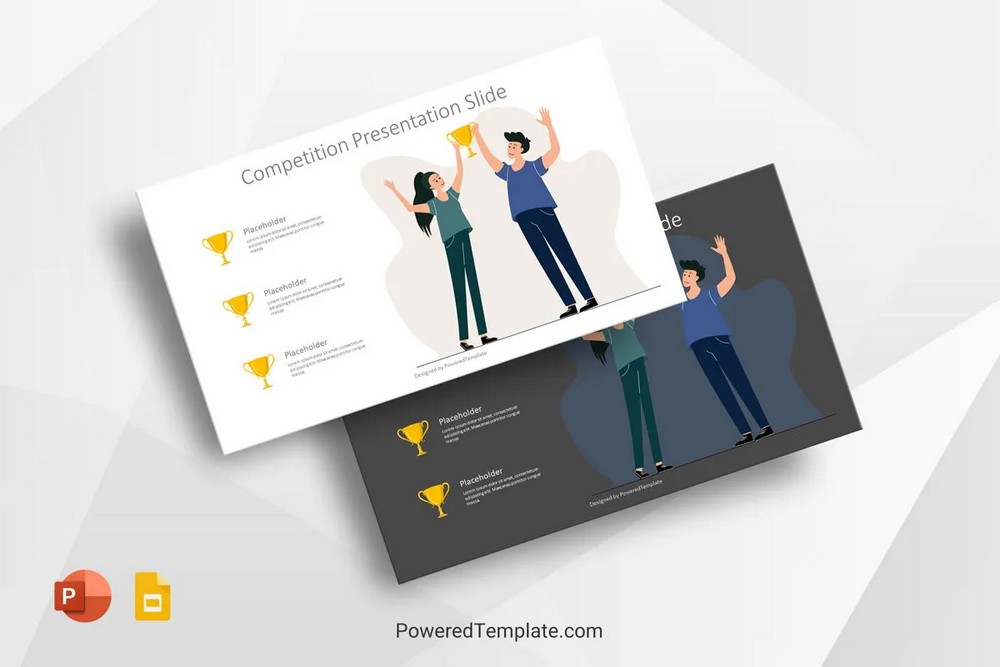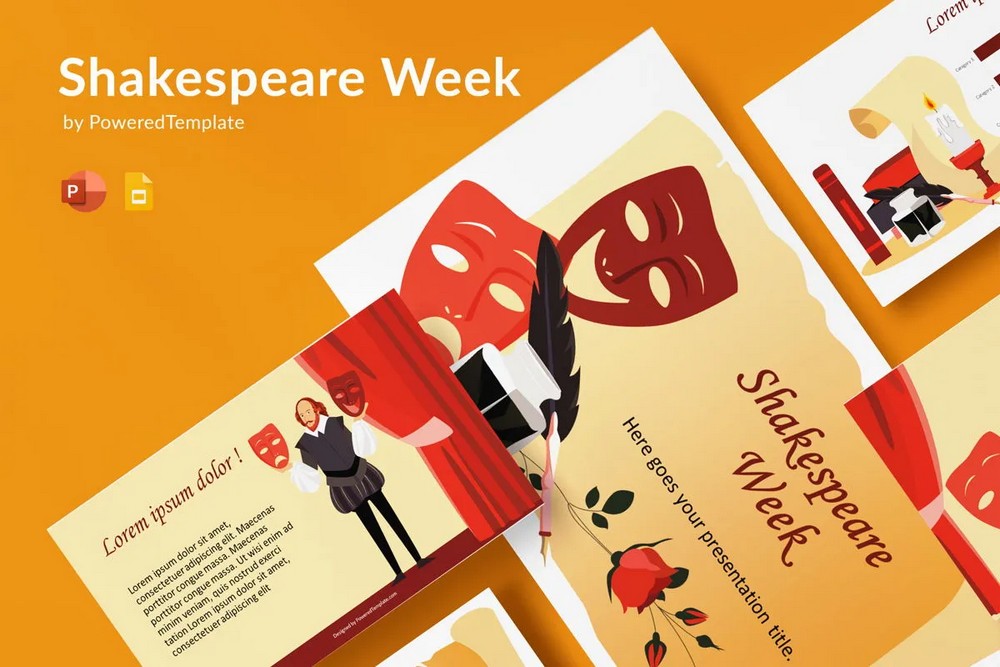By weaving a compelling narrative into your slides, you can transform your presentations into immersive experiences that resonate with your audience. This guide will take you through the process of understanding your audience, defining a key message, structuring the narrative, and crafting impactful text.
In addition to the expert guidance, this guide offers free presentation templates that align with the principles discussed, allowing you to put your newfound knowledge into practice easily. Whether you’re a business professional, educator, or presenter looking to captivate your audience, this guide will equip you with the tools and strategies to create memorable and persuasive presentations.
Below, we intentionally omitted the topic of slide design, as we dedicated a previous article to this important subject.
Table of Contents
- Importance of a Compelling Narrative in Slides
- Understanding the Audience
- Defining the Key Message
- Structuring the Narrative
- Crafting Compelling Text
- Practicing and Refining
- Weave Your Compelling Narrative with Our Free Presentation Templates
- Conclusion
Importance of a Compelling Narrative in Slides
A compelling narrative goes beyond simply presenting information and engages the audience on an emotional and intellectual level. Incorporating a compelling narrative in your slides is vital for capturing attention, enhancing comprehension, creating a memorable experience, building emotional connections, making complex information accessible, and increasing your overall persuasiveness and influence.

By weaving a strong narrative throughout your presentation, you can transform it into a powerful tool for engaging and inspiring your audience.
Understanding the Audience
Understanding your audience is crucial for crafting a compelling narrative that resonates with them. By tailoring your narrative to their specific interests and needs, you can create a more impactful and engaging presentation.

Here are the key aspects of understanding your audience:
Identifying the Target Audience
To create a compelling narrative, it’s essential to identify and define your target audience. Consider the following:
- Demographics: Determine the demographic characteristics of your audience, such as age, gender, occupation, and educational background. This information helps you tailor your language, examples, and content to suit their preferences.
- Psychographics: Understand the psychological aspects of your audience, such as their values, attitudes, interests, and motivations. This knowledge allows you to align your narrative with their beliefs and desires.
Analyzing their Interests and Needs
Once you’ve identified your target audience, it’s important to analyze their interests and needs. Consider the following strategies:
- Research: Conduct thorough research to gather insights about your audience’s interests and preferences. This can involve reviewing industry reports, conducting surveys, or analyzing social media trends. The more you know about their interests, the better you can tailor your narrative to capture their attention.
- Prioritize: Identify the primary interests and needs of your audience. Determine the key challenges they face or the goals they are striving to achieve. This understanding enables you to focus your narrative on addressing their specific pain points or providing solutions that meet their needs.
Tailoring the Narrative to Resonate with the Audience
Once you have a clear understanding of your audience, it’s time to tailor your narrative to resonate with them effectively. Here’s how you can accomplish this:
- Emotional Appeal: Identify the emotions that resonate with your audience and incorporate them into your narrative. Whether it’s excitement, inspiration, or empathy, evoking the right emotions can create a powerful connection and make your presentation more memorable.
- Relevance: Ensure that your narrative is relevant to your audience’s context. Use examples, anecdotes, or case studies that reflect their experiences or industry. By relating your narrative to their world, you increase its relatability and impact.
- Customization: Personalize your narrative whenever possible. Incorporate specific references or stories that directly address the interests, needs, or challenges of your audience. This customization demonstrates that you understand them and increases their engagement with your presentation.

By understanding your audience, analyzing their interests and needs, and tailoring your narrative to resonate with them, you can create a compelling presentation that connects with your audience on a deeper level. This understanding forms the foundation for crafting a narrative that engages, informs, and inspires your listeners.
Defining the Key Message
Defining a clear and concise key message is essential for crafting a compelling narrative in your slides. It acts as the central idea or core theme of your presentation, guiding the development of your narrative.

Here are the key elements of defining the key message:
Identifying the Core Message or Main Idea
To define the key message, you need to distill the essence of your presentation into a single, focused statement. Consider the following:
- Central Purpose: Determine the primary objective of your presentation. Is it to inform, persuade, inspire, or entertain? Understanding the purpose helps you identify the main idea that aligns with your goal.
- Unique Value: Identify the unique value or proposition that your presentation offers to the audience. What sets it apart from other information or perspectives? This unique value becomes the foundation of your key message.
Ensuring Clarity and Focus
A compelling narrative requires clarity and focus to effectively communicate your key message. Consider the following strategies:
- Simplicity: Express your key message in simple and concise language. Avoid jargon or complex terminology that might confuse or alienate your audience. Aim for clarity and accessibility.
- Single Focus: Ensure that your key message has a single, central focus. Trying to convey too many ideas can dilute the impact of your narrative. Stay focused on the core message to maintain a coherent and powerful narrative.
Crafting a Strong Central Narrative that Supports the Key Message
Once you have defined your key message, it’s important to craft a narrative that supports and reinforces it. Consider the following approaches:
- Storytelling Structure: Structure your narrative like a story, with a clear beginning, middle, and end. The narrative arc should lead the audience from the introduction to the resolution, all centered around your key message.
- Supporting Points: Identify supporting points or sub-messages that contribute to the overall narrative. These points should align with and strengthen the key message, providing evidence, examples, or insights that support its validity.
- Consistency and Coherence: Ensure that every element of your narrative, including visuals, text, and examples, aligns with the key message. Consistency and coherence create a unified and persuasive narrative that resonates with the audience.
By defining a clear and focused key message, ensuring its clarity and focus, and crafting a strong central narrative that supports it, you create a solid foundation for a compelling presentation. The key message acts as the compass that guides the development of your narrative, helping you deliver a memorable and impactful presentation.
Structuring the Narrative
Structuring your narrative effectively is crucial for weaving a compelling story through your slides. A well-structured narrative engages the audience, maintains their interest, and delivers your key message in a coherent and impactful manner. Here are the key elements of structuring your narrative:
Introduction
The introduction sets the stage for your presentation and captures the audience’s attention from the start.

Consider the following components:
- Setting the Context: Provide background information or context that establishes the relevance and importance of your topic. Help the audience understand why they should care about the subject matter.
- Grabbing the Audience’s Attention: Begin with a captivating hook or attention-grabbing statement. It could be a thought-provoking question, a startling fact, a compelling story, or a powerful quote. The goal is to pique the audience’s curiosity and make them eager to hear more.
Building the Story
The body of your presentation builds upon the introduction and develops the narrative. Consider the following strategies:
- Identifying Key Plot Points or Ideas: Determine the main ideas or plot points that support your key message. These ideas act as building blocks for your narrative and help guide the flow of information.
- Sequencing the Information Logically: Arrange the plot points or ideas in a logical sequence that creates a coherent and easy-to-follow storyline. Consider using a chronological order, cause-and-effect structure, or problem-solution approach, depending on what best suits your content.
- Establishing a Clear Beginning, Middle, and End: Ensure that your narrative has a clear structure with a beginning, middle, and end. The beginning introduces the topic and sets up the conflict or challenge. The middle elaborates on the main ideas, providing supporting details and evidence. The end offers a resolution, conclusion, or call to action.
Creating a Storyline
To make your narrative engaging and relatable, consider incorporating elements of storytelling.

Here are some techniques:
- Incorporating Conflict or Challenges: Introduce a central conflict or challenge that your audience can identify with. This creates tension and keeps the audience invested in your narrative. It could be a problem faced by your target audience or an industry-wide challenge.
- Presenting Solutions: Offer solutions, insights, or strategies that address the conflict or challenges presented. Present them in a clear and actionable way, emphasizing the value they provide. Show how your key message and supporting points contribute to resolving the conflict or overcoming the challenges.
Transitioning Between Sections
Smooth transitions are essential for maintaining a cohesive flow in your narrative. Consider the following approaches:
- Using Effective Transitions to Maintain a Flow: Use transitional phrases, such as “now,” “moving on,” or “next,” to signal transitions between sections. These cues help the audience follow the narrative and understand the progression of ideas.
- Creating Smooth Connections Between Ideas: Establish connections between ideas by using linking words or phrases that show the relationship between concepts. Examples include “similarly,” “in contrast,” “additionally,” or “consequently.” These connections ensure a seamless flow of information and enhance comprehension.

By structuring your narrative with a compelling introduction, building a coherent story with logical sequencing, creating engaging storylines, and incorporating smooth transitions, you can deliver a presentation that captivates and resonates with your audience. The structure acts as a framework for your narrative, ensuring that it flows smoothly and delivers your key message effectively.
Crafting Compelling Text
In addition to a well-structured narrative, crafting compelling text in your slides is crucial for effectively conveying your message and engaging your audience. Here are key strategies for crafting compelling text:
Using Concise and Impactful Wording
To make your text more engaging and memorable, focus on using concise and impactful wording. Consider the following tips:
- Simplify Language: Use clear and simple language that is easily understood by your audience. Avoid jargon or complex terminology that might confuse or alienate listeners. Aim for brevity and clarity in your text.
- Be Direct and Specific: Communicate your ideas in a direct and specific manner. Avoid vague or ambiguous language that can dilute the impact of your message. Use concrete examples and precise wording to make your text more compelling.
- Emphasize Key Points: Highlight key points or important information using formatting techniques such as bolding, italicizing, or using larger font sizes. This draws attention to the essential elements of your text and makes them stand out.
Utilizing Storytelling Techniques
Storytelling techniques can add depth and engagement to your text. Consider the following approaches:
- Use Vivid Descriptions: Incorporate descriptive language that appeals to the senses and creates vivid mental images. This helps the audience visualize your ideas and connect with your message on a deeper level.
- Create Narrative Flow: Structure your text in a narrative format, with a clear beginning, middle, and end. Use storytelling elements such as exposition, rising action, climax, and resolution to create a compelling narrative flow in your text.
- Employ Metaphors and Analogies: Use metaphors or analogies to illustrate complex concepts or ideas. These figures of speech can make your text more relatable and help the audience grasp abstract or unfamiliar concepts by relating them to something familiar.
Incorporating Relevant Quotes, Anecdotes, or Statistics
Quotes, anecdotes, and statistics can add credibility and interest to your text. Consider the following strategies:
- Quotes: Include relevant quotes from experts, thought leaders, or influential individuals in your field. Quotes can provide insights, perspectives, or support for your key message. Ensure that the quotes align with your narrative and resonate with your audience.
- Anecdotes: Share personal anecdotes or stories that illustrate the ideas or concepts you’re presenting. Anecdotes make your text more relatable and engaging, allowing the audience to connect with your message on a personal level.
- Statistics: Incorporate relevant statistics or data to support your arguments or claims. Statistics provide evidence and credibility to your text, making it more persuasive. Ensure that the statistics are from reliable sources and presented in a clear and accessible manner.

By using concise and impactful wording, utilizing storytelling techniques, and incorporating relevant quotes, anecdotes, or statistics, you can make your text more compelling and captivating.
Remember to keep your text focused, clear, and aligned with your key message to effectively communicate your ideas to the audience.
Practicing and Refining
Practicing and refining your presentation is essential for delivering a polished and impactful narrative. This section focuses on key steps to enhance your presentation through practice and feedback.
Rehearsing the Presentation
Rehearsing your presentation helps you become more familiar with the content and improve your delivery. Consider the following practices:
- Practice Timing: Time your presentation to ensure it fits within the allocated timeframe. This helps you maintain a steady pace and avoid rushing or going over time during the actual presentation.
- Use Visual Aids: Practice incorporating visual aids, such as slides or props, into your presentation. Familiarize yourself with the visual cues and transitions to ensure a smooth integration.
- Speak Out Loud: Practice speaking your presentation out loud to develop a natural flow and comfortable delivery. Pay attention to your tone, pace, and emphasis on key points to effectively engage the audience.
Seeking Feedback and Making Improvements
Feedback from others provides valuable insights and perspectives that can enhance your presentation. Consider the following feedback-seeking strategies:
- Peer Review: Share your presentation with colleagues or friends and ask for their feedback. Request their input on the clarity of your message, the organization of your content, and the overall impact of your narrative. Incorporate their suggestions to refine your presentation.
- Professional Guidance: Seek feedback from experienced presenters or mentors who can provide constructive criticism. They can help you identify areas for improvement and offer specific advice on enhancing your storytelling, visuals, or delivery.
Ensuring Coherence and Flow in the Narrative
A coherent and flowing narrative is essential for capturing and maintaining the audience’s attention. Consider the following approaches:
- Smooth Transitions: Pay attention to the transitions between different sections or ideas in your presentation. Practice using transitional phrases or visual cues to ensure a seamless flow and logical progression of information.
- Consistent Visual Design: Ensure visual consistency throughout your slides by using a cohesive design scheme, fonts, colors, and imagery. Consistency helps create a unified narrative and enhances the overall professional appearance of your presentation.
- Storyline Check: Evaluate the overall narrative structure to ensure coherence and clarity. Ensure that the story flows logically, the key message is reinforced consistently, and supporting points align with the central theme. Make necessary adjustments to strengthen the narrative.

By rehearsing your presentation, seeking feedback from others, and refining your content based on the feedback received, you can improve the coherence, delivery, and impact of your narrative. Practice and refinement allow you to fine-tune your presentation to resonate more effectively with your audience and deliver a compelling storytelling experience.
Weave Your Compelling Narrative with Our Free Presentation Templates
To assist you in crafting a compelling narrative for your slides, we offer a collection of free presentation templates. These templates are designed to enhance your storytelling and create visually engaging presentations.
Our templates come with pre-designed slide layouts that offer a well-organized structure for your content. These layouts include sections for introduction, main points, supporting visuals, and conclusion, making it easier for you to weave your narrative seamlessly.
Our templates feature visually appealing elements, such as high-quality images, icons, and graphics, that can enhance the visual impact of your slides. These elements help convey your message effectively and create a visually engaging experience for your audience.
By using our free templates, you can save valuable time that would otherwise be spent on designing your slides from scratch. Our templates provide a ready-to-use foundation, enabling you to focus more on crafting your compelling narrative and refining your content.
Conclusion
In conclusion, weaving a compelling narrative through your slides is crucial for capturing and maintaining your audience’s attention. By understanding your audience, defining a key message, structuring your narrative effectively, crafting compelling text, and practicing and refining your presentation, you can create a powerful and memorable storytelling experience.
With these tools and strategies at your disposal, you can weave a compelling narrative that captivates your audience, conveys your message effectively, and leaves a lasting impression. Embrace the power of storytelling in your slides and unleash the full potential of your presentations.


